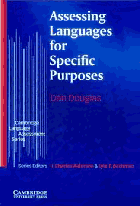
| "Today LSP test tasks frequently have a high degree of situational authenticity (reflecting actual target language use characteristics), but a low degree of interactional authenticity (failing to engage examinees in communicatively purposeful activities.)" |
[ p. 7 ]
the very nature of the LSP testing enterprise means that there will always and inevitably be a reduction in the dynamic interplay between the test taker and the characteristics of the test task, because a test is, by definition, a controlled and contrived environment. (p. 278)
- Reviewed by Tim Newfields
| Categorical Index | Subject Index | Title Index |
[ p. 8 ]